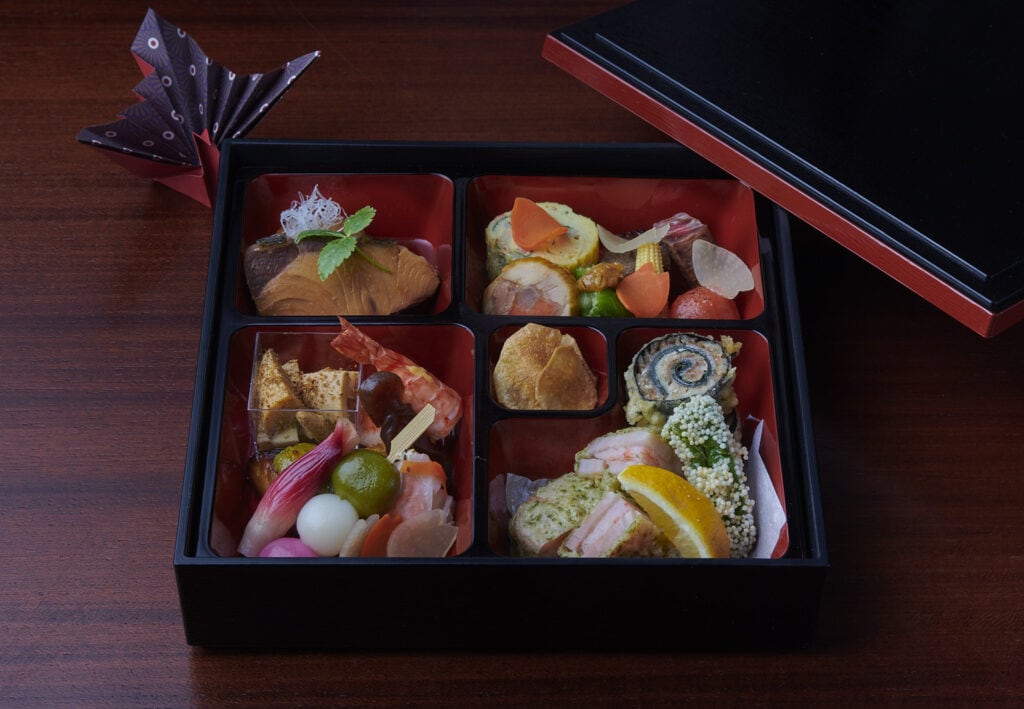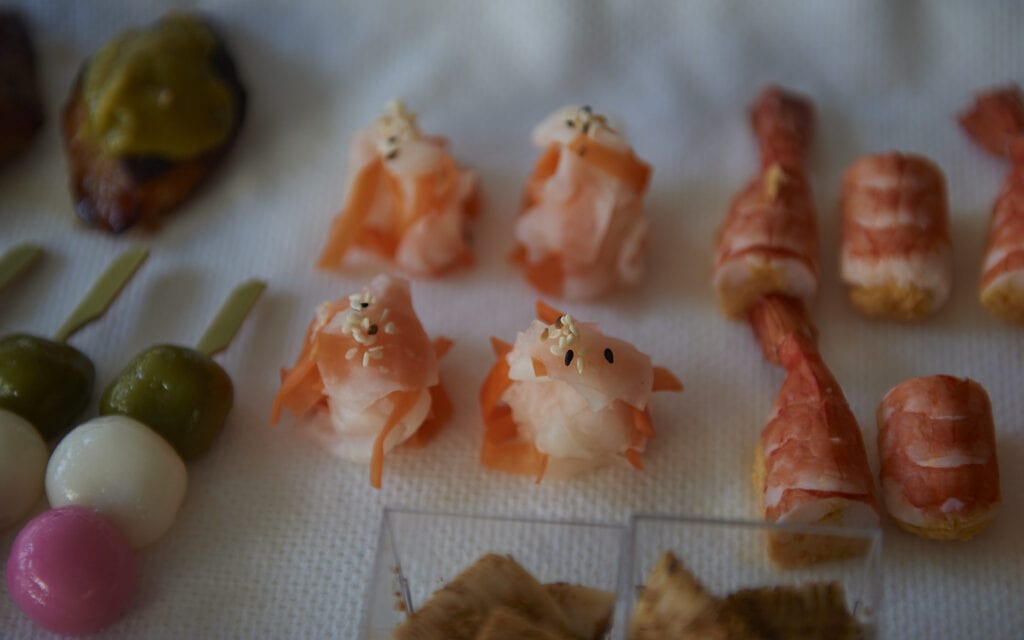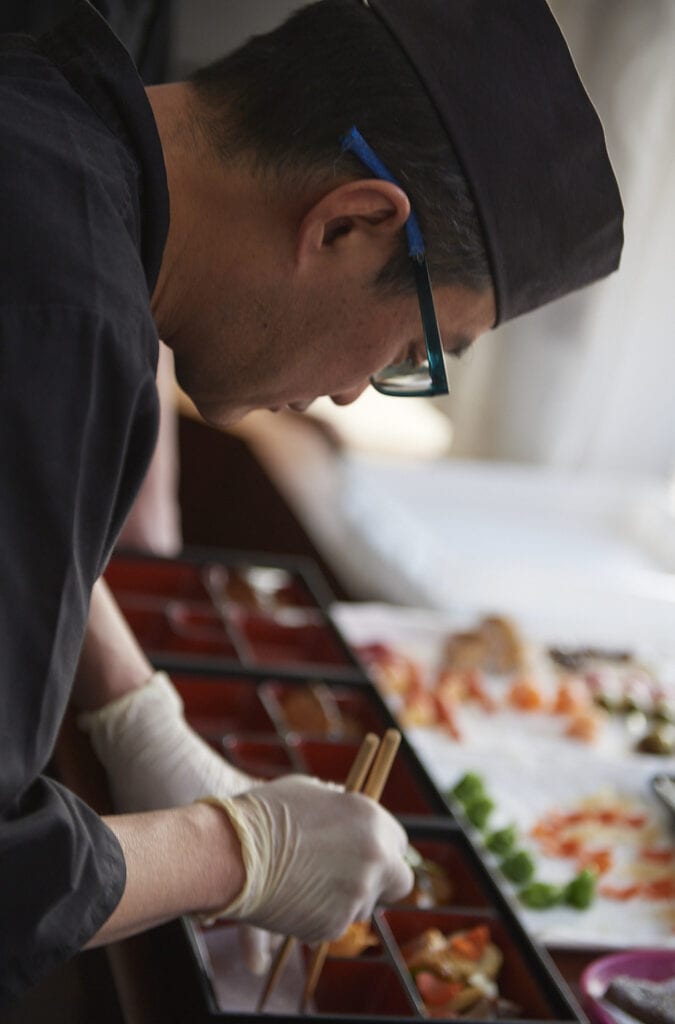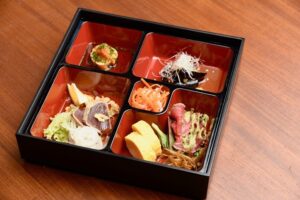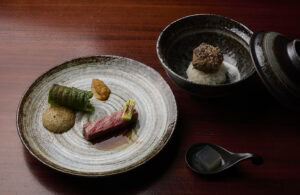Japanese Bentō are - made by expert hand - truly small culinary treasure chests.
It is often said that one of the unique features of the Japanese cuisine is that it is first enjoyed with the eyes and only then tasted with the tongue. In Japanese dining culture, the tableware used plays a major role - and so does the technique used to present and arrange food on the dinnerware, called moritsuke. And especially in the case of a premium Bentō, it is a very special feeling when you actually open the box and can first take a look at the various little works of art that have been arranged with a lot of handwork.
Special Bentō for special guests
The Fukiyose Bentō (吹寄, a lyrical phrase for a Bentō, which is made up of various fine ingredients thrown together) that we at Restaurant sansaro recently had the pleasure of preparing at the request of high-profile Japanese clients in Munich was indeed such a culinary treasure trove.
Filled with a variety of handmade delicacies and colorful spring-inspired dishes, we would like you to share what our kitchen has conjured up on March 24, 2022.
Update: other Bentō for these guests included. in April, in summer and autumn, each in itself always worth seeing, experiencing and of course eating 😉
Ichi-no-masu (壱の枡)
The description of the dishes starts in the lower left compartment, which you will quickly recognize by the three round balls in different colors, the Japanese dango (rice flour dumplings).
Grilled sakuradai (桜鯛, cherry sea bream) with kinome miso glaze.
In Japan, Tai (鯛, sea bream), caught between March and May when cherry blossoms are in full bloom, are called Sakuradai.
This time of year is considered one of the "seasons" for sea bream as they hug their eggs before spawning in early summer, hence the special name. Japanese are filled with an inner feeling of spring just hearing the name.
Sakuradai tastes good boiled, grilled or as sashimi. This time, we topped the fish with Kinome miso and baked it in the oven, making it crispy on the surface and fluffy on the inside. Kinome miso we also used in a Mini sake tasting individual recently presented, is a unique sauce for this time of year, which brings the scent of spring to our customers.
Twisted konjac root pickled in sweet soy sauce
Konnyaku, a popular food in Japan made from the flour of konjac root, is twisted with a slit in the middle to allow the flavor to soak in well, and then cooked in sweet and salty soy sauce and mirin (sweet cooking sake). Even those who don't normally like konnyaku will enjoy the taste of this pickled and the special chewing sensation of the twisted folded konnyaku in this box.
Shrimp egg yolk sushi
Ebi Kimi Sushi is a dish that is not often prepared in Munich, because instead of vinegar rice, a paste of boiled egg yolk is used. In Japan, cooked egg yolk is mixed with sweet potato and seasoned with vinegar, sugar, salt, etc. However, in this case, sweet potato paste is added to give the dish a natural sweetness. This dish is served as an appetizer in the kaiseki rori, the specialty of our chef Riichiro Matsui.
Bamboo shoots (八方) simmered in Happō, with chopped mackerel flakes as garnish.
Seasonal bamboo shoots are cooked in Happo soup broth and dusted with saba bushi powder (鯖節, mackerel flakes) to add flavor and richness.
Shiho-Happō (四方八方), which means "any direction" in Japanese ("Shiho" refers to the four directions of east, west, south, north, and west. "Happo" is the four directions plus the four corners, i.e., northeast, northwest, southeast, and southwest).
Happō-Dashi broth is a perfect all-purpose soup that can be used to enhance the flavor of any ingredient. It is made by mixing dashi soup broth made from dried bonito flakes and seaweed with Shoyu and mirin are made. The slight bitterness of the bamboo shoots, crunchy and pleasantly chewy, also reminds Japanese of spring.
Sanshoku dango (三色, tri-color dango) made from glutinous flour, turnip and carrot cut into fine strips sweet and sour marinated, sweet and sour pickled myogrape.
Tri-color dango dumplings with a hint of sweetness depicting cherry buds, blooming flowers and green leaves. Turnips and carrots in a vinegar-sugar sauce (called namasu in Japanese) are refreshingly elegant. The bright red color of myoga pickled in vinegar adds an extra splash of color to the bento.
In this corner alone, the five flavors (salty, sweet, sour, bitter and umami) that are so important in Japanese cuisine are well balanced.
Ni-no-masu (弐の枡)
It continues in the upper left compartment, immediately recognizable in the picture by the small green mitsuba leaf.
Braised yellowtail mackerel (鰤, buri) and daikon (white radish).
Buri and daikon are seasoned with sake, soy sauce, mirin, sugar and ginger. The broth with the added flavor of buri is slowly absorbed into the daikon.
In Japan, the yellowtail changes names several times as it grows (Tsubasu > Hamachi > Mejiro > Buri). It is therefore said to be a fish that climbs the ladder of success.
Buri has the peak of its season in February, which is the so-called "Nagori" (名残) season. But in spring, when the old year ends in Japan at the end of March and in many ways a new beginning is made afterwards, the "success fish" is a dish that brings good luck.
By the way, the literal translation of the word "Nagori" is "a name" (名) "that remains" (残). It means that the influence of things, even if they have passed, remains or that one is sorry to say goodbye. Japanese love a certain lyrical sentimentality - but that's another story.
San-no-masu (参の枡)
Continuing clockwise, the upper right compartment of our special Fukiyose Bentō features some finely fried specialties.
River eel rolled with shiso perilla baked in tempura coat
The fat eel is rolled up with shiso (Ōba) leaves, which fit well together, and fried. The dish is called "Naruto" because the swirls in the cross-section of the dish resemble the appearance of a swirl of tidal currents called "Naruto" in the Strait of Japan.
In Japanese cuisine, it is interesting to pay attention to the name of the dish.
In the Kansai region, there is a place called Naruto, which is of course famous for its whirlpools, and the spring tides are the biggest of the year.
Lotus root with shrimp baked in tempura coat
Fluffy shrimp, gently crushed with a chef's knife, are nestled between the slightly firmer lotus root. This brings a deliberate alternation between the different textures, crunchy and soft.
Fried peppers with arare rice cracker coat (あられ) baked out
Shishito peppers are dipped in egg white and deep fried on the surface with rice grains called arare. The literal translation of the word "arare" means "hail." It has a different crispy texture than panko breadcrumbs. Fried arare can be combined with a variety of ingredients such as vegetables, tofu and fish.
Yon-no-masu (肆の枡)
Finally, the lower right compartment, easily recognizable by the small lemon.
Kagosihma wagyu marinated in miso and grilled
Kagoshima beef, known for its tender texture, is soaked overnight in a paste made from miso and mirin and then grilled until succulent.
Boiled chicken leg Ichimatsu style (市松) with carrots and daikon as a roulade.
Thin, rectangular slices of radish and carrot are lined up and wrapped with chicken meat, then cooked in a soy sauce-based broth and sliced to create what is called a checkerboard pattern.
In Japan, this pattern is called "Ichimatsu", and the uninterrupted series of squares means prosperity for the descendants and the expansion of business.
The name comes from the pattern of the kimono worn by Ichimatsu Sanogawa, a Kabuki actor of the Edo period.
Japanese omelet with crab meat and mitsuba, Japanese sliced cucumber with moromi miso, carrots and radish sliced into flower shape.
The egg omelet (always made with organic eggs in our house, of course, for many years now) is colorfully mixed with crab meat and fresh mitsuba leaves in season.
Janbara cucumbers with moromi miso (jabara is the belly of a snake). The name comes from the curled shape of the cucumber, which is cut with a knife into tiny pieces that resemble the belly of a snake. It is served with daikon and carrots in the shape of petals.
Ko-masu (小枡)
Finally, in the middle, what looks like potato chips.
Jerusalem artichoke chips
Jerusalem artichoke is sliced and deep-fried like French fries. Their crunchy texture is just the right lightness for hashi yasume (箸休め), a "chopstick break" for a little change of rhythm while enjoying the whole composition.
Bentō in the highest quality
We take great pleasure in showing and interpreting Japanese cuisine in high quality for our guests. What aspects around Bentō are you interested in?
Write us what you want to know via the contact form on our homepage www.sushiya.de and subscribe to our newsletter to be there when we offer another special.
